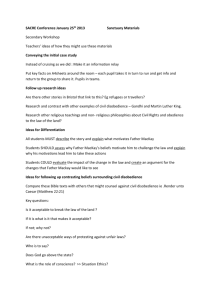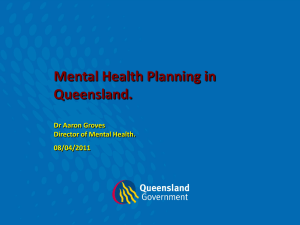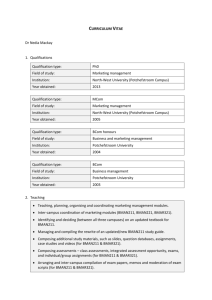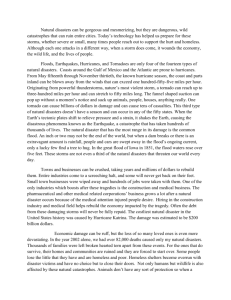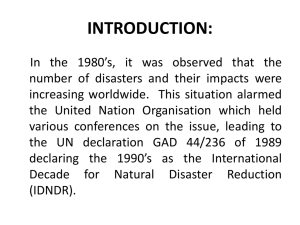Submission DR133 - Mackay Regional Council
advertisement
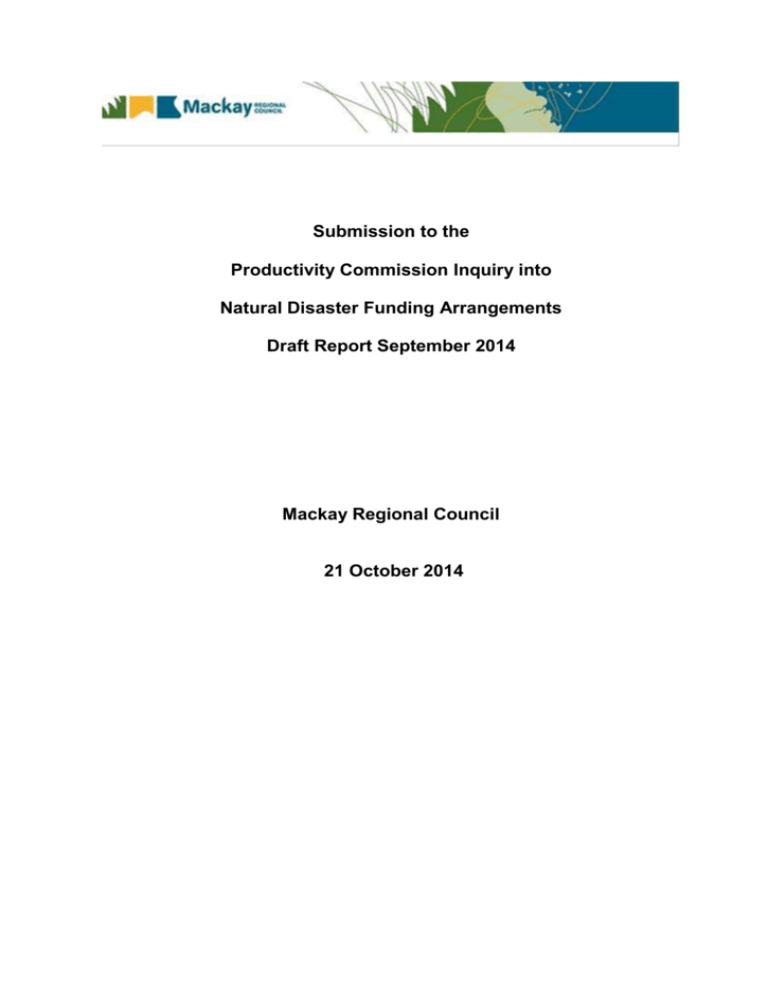
Submission to the Productivity Commission Inquiry into Natural Disaster Funding Arrangements Draft Report September 2014 Mackay Regional Council 21 October 2014 Introduction The Mackay Regional Council (the Council) has a resident population of 122,000 and a gross regional product of $6.624 billion. The region has experienced decades of urban growth most recently due to major mining investment in the coal regions it services. This growth has made Mackay one of the fastest growing regions in Queensland and whilst growth has slowed with the downturn in the resources sector it will continue to grow by about 40,000 people over the next 12 years. Mackay was founded on the banks of the Pioneer River in the early 1860s as a coastal trading centre servicing the agriculture, beef and timber industries which developed on the fertile valley of the Pioneer River. Mackay is exposed to flooding and coastal hazards with significant past events including the 1958 Pioneer River flood, the 2008 flash flood and the 1918 cyclone and storm tide, as well as suffering the affects of several tropical cyclones in recent years. Both the 2008 flood and 1918 storm tide had probabilities of occurrence greater than 0.2 percent Annual Exceedance Probability (AEP) or 1 in 500 annual chance. Mackay has constructed a significant network of levee banks since the 1958 flood to provide immunity to near to 1percent AEP (1 in 100 annual probability) but because of its geography and location continues to be vulnerable to flood and cyclone activity. As a result of much of its development being on a flood plain, its continued growth, and the decentralised nature of the municipality, the Council faces high infrastructure costs on roads, water, sewer, stormwater, parks, and community facilities. Due to its relatively small rates base the Council is dealing with the significant challenge of building and maintaining its public infrastructure and is necessarily reliant on financial assistance from the state and Australian governments through programs such as the Natural Disaster Relief and Recovery Arrangements (NDRRA). For example, the Council manages a network of over 2,400 kilometres of roads across an area of 7,261 square kilometres. Major rainfall events and natural disasters between 2008 and 2012 caused extensive damage to Council's road network resulting in an intensive repair and restoration effort. The events over this five-year period required the Council to undertake work costing over $270 million to repair its damaged road network; about 88 percent of these costs were met by the NDRRA program. Funding arrangements for recovery Mackay Regional Council’s rates are amongst the highest in Queensland with little scope in the future for anything other than moderate increases. Council is dealing with this by applying tight and strategic financial management. This has included developing a Regional Sustainability Strategy which provides a carefully considered long term strategy for the sustainable development of the Mackay region. The Council has also made significant cuts to its operating costs and factored the need to find additional savings on an annual basis in its financial projections. In addition, Council is exploring new and innovative service delivery models to further reduce operating costs. According to the latest ABS data local governments are responsible for only 3.38 percent of total taxation revenue collected across the sphere of government1. Whilst local governments’ roles have expanded, grants as a percentage of total revenue have fallen 2. The recently announced freeze on the indexation of Financial Assistance Grants from the Australian Government exacerbates this already challenging situation. 1. Source: ABS Cat. 5506.0 Taxation Revenue Australia 2012-13 2. Comrie, J. 2013, In our hands: strengthening Local Government revenue for the 21st Century, ACELG, UTS p.23 Submission on the Productivity Commission’s draft report on Natural Disaster Funding Arrangements Mackay Regional Council Draft Version 0.2 dated 15 Oct 14 Page 1 Due to this limited revenue pool, local governments, particularly smaller regional Councils are much more sensitive to the financial consequences of disasters and are therefore heavily reliant on the other tiers of government for support. As a coastal community in tropical north Queensland Mackay faces increasing climate and weather related risks and consequently is more exposed to the impact of natural disasters. For example: Climate change is projected to amplify existing climate related risks such as a rise in sea level by between 0.53m and 0.97m by 21003 Previous guidelines from the Queensland Government which have been used in Mackay Regional Council’s storm tide study recommended a 0.8m sea level rise and an increase in cyclone maximum potential intensity by 10 percent by 2100 due to climate change4 Local governments should factor in a 5 percent increase in rainfall intensity per degree of global warming using the following temperature increases and timing: 20 C by 2050, 30 by 2070 and 40 by 21005 The risk of natural disasters is increasing, and the Council is responding accordingly by factoring these risks into its enterprise risk management processes, its infrastructure planning, long term financial planning, and its planning scheme. Council is operating prudentially and responsibly in the face of a very challenging financial environment. Despite these efforts the Council like most other local governments, does not have the capacity to absorb the additional natural disaster related costs foreshadowed in the report. A $1million increase in costs for the Council equates to approximately a one percent increase in general rates. It would be untenable to raise rates beyond the current projections, and virtually impossible to raise them to a level which covers the additional costs likely to be passed to local government as a result of the changes recommended in the draft report. The Council strongly opposes the proposed funding model as it does not take in account the unacceptable consequences on local governments, particularly those such as Mackay Regional Council which face greater natural disaster risks both in terms of likelihood and consequence and have limited scope to increase revenue It is recommended that the Australian government work with state governments and local governments to develop funding models which recognise the relative financial capacities of each tier of government to ensure that the burden of natural disasters is shared fairly and take into account the risk profiles of those local governments facing the highest risks. The proposal to provide state governments with increased autonomy to manage relief and recovery expenditure is supported, particularly the removal of restrictions on the use of ‘day labour’ and allowing greater freedom to apply betterment options. The current arrangements discourage betterment which includes many sensible practices that provide longer term mitigation effects. For example, Councils have traditionally been required to undertaken like-for-like road repairs on NDRRA projects as betterment costs have had to be fully borne by the Council and any subsequent damages at these locations did not qualify for NDRRA funding. 3. IPCC, 2014 Summary for policymakers 4. Queensland Coastal Plan – Coastal Hazards Guideline DERM Qld Government 2012 5. Increasing Queensland’s resilience to inland flooding in a changing climate: Final report on the inland flooding study Qld Government, 2010 Submission on the Productivity Commission’s draft report on Natural Disaster Funding Arrangements Mackay Regional Council Draft Version 0.2 dated 15 Oct 14 Page 2 This has been exacerbated by ‘fitness for purpose’ construction standard designs, effectively limiting road design to 10-year traffic loadings. In addition, funding does not allow for the installation of sub-surface drains which are essential for the proper performance of pavements. It should be noted that some natural disaster events cover more than one financial year. For example the events experienced by the Council in recent years crossed over financial years. Therefore the proposed funding model, including any discussion on annual thresholds etc should be cognisant of this. However the proposal to calculate payments ‘up-front’ based on an assessment of damage places an unreasonable share of the risk of incorrect estimation on local government. Upfront cost assessments without ability for later adjustments could lead to significant over estimation in order to cover market rates given that the unit rates for such works would be relatively unknown at the stage of initial assessment given no ability exists to test the market at this point in time as well as the impact for scope adjustment to cover consequential damage. The current arrangement allows adjustments for both actual tendered rates and for scope creep to cover valid consequential damage assessments subject to verification. Without this ability it would be assumed that significant risk allocation will need to be built into initial assessments to ensure scope and unit rate values are adequate. It is recommended that flexibility be built into the funding model to allow for unforseen but essential expenditure not allowed for in the initial damage assessment to be claimable Funding arrangements for mitigation The proposal in the report to increase funding for mitigation is supported. The Council is undertaking a major study called the Mackay Region Coastal and Inland Flood Hazard Adaptation Study (CIFHAS) which will identify the priority infrastructure requirements to provide protection for the most vulnerable areas. The Council will undertake an economic assessment of costs and benefits of all options in the CIFHAS to ensure that the infrastructure investment is appropriate and targeted. The Council however challenges the recommendation in the draft report that the distribution of mitigation funds to states should be on a per capita basis. This would result in inequitable outcomes. For example, Victoria which has historically faced much lower natural disaster risks than Queensland would receive more mitigation funding that Queensland. It is recommended that the distribution of funds to states should be based on risk rather than population Government Insurance The proposal that state and territory governments further investigate non-traditional insurance products for roads should be undertaken prior to the Commission finalising its report. Insurance will be a critical factor in the affordability equation for local governments. The investigations will also serve to identify any prescribed information and asset management requirements of potential insurers. It will also identify the implications on Councils with different asset bases and risk profiles which in turn will challenge the notion of a one-size-fits-all approach to funding arrangements. Submission on the Productivity Commission’s draft report on Natural Disaster Funding Arrangements Mackay Regional Council Draft Version 0.2 dated 15 Oct 14 Page 3 In contrast to the Victorian state government and the ACT examples it is understood that the Queensland state government was unsuccessful in obtaining insurance for its network of state roads. The Council has made approaches to its insurer who has advised that past investigations along these lines for local governments have had the same outcome. In summary, it is very likely that insurance for Queensland local roads will be discounted as a viable option; even if insurance were available for local road networks, the premiums would be preclusively expensive. It is recommended that the investigations into the availability and affordability of government insurance for roads be undertaken prior to the finalisation of the new funding model so that outcomes can be factored into the future funding arrangements. Information Draft finding 4.1 which identifies the scope for greater coordination and prioritisation of natural hazard research activities across governments and research facilities is supported It is suggested that the recommendation be enhanced to include the need for governments to play a greater role in coordinating modelling and research with an increased emphasis on a regional and state-wide scale rather than individual Councils focussing on individual studies. Regulating the built environment Draft recommendation 4.7 recommending that the provisions in the Queensland Sustainable Planning Act 2009 for injurious affection be repeal is supported. The Council notes that the state government is addressing this through its draft Planning and Development Bill 2014 in Part 5 Section 25(4)(e)(i) In order to better protect local governments in Queensland from liability for personal and private damage resulting from actions taken or information provided to manage the risk of natural disasters legal advice indicates that greater statutory protection is required. Accordingly, the Council is sponsoring a motion at the 2014 LQAQ Annual Conference supporting the enactment of legislative provisions to protect Councils from liability from decisions made, or advice provided regarding natural hazards. The suggested approach is to provide broad indemnity similar to that contained in section 733 of the New South Wales Local Government Act 1993. It is recommended that the report ask state governments to consider adopting broad statutory indemnity provisions similar those in section 733 of the Local Government Act 1993 (NSW) Infrastructure Draft Recommendation 4.10 which calls for a clearer link to road user preferences in maintenance and investment decisions is supported. However if applied rigidly, selecting projects to be funded based on a net community benefit test as proposed may adversely affect the Council’s rural and unsealed road network infrastructure. These roads link rural and remote properties and localities but have small traffic loadings so the gross social and economic benefits community benefits generated would be limited. Without a Submission on the Productivity Commission’s draft report on Natural Disaster Funding Arrangements Mackay Regional Council Draft Version 0.2 dated 15 Oct 14 Page 4 qualification to the community benefit test these roads would have limited access to funds and would be outside the Council’s ability to fund proper restoration after significant events. This would result in the lowering of asset and service standards on these networks and ultimately higher rehabilitation and reconstruction costs in the longer term. The same principle applies to urban regional networks which would be in competition with larger population and traffic centres including the state road network. It is recommended that equity for people in rural and regional areas be a consideration when assessing the net community benefits of road infrastructure projects. Summary A reduction in the reimbursement rates together with the proposed increase in the small disaster criterion and the annual state government thresholds, when passed through to local government is likely to make the restoration of essential public assets, particularly roads, unaffordable. If left unchanged it is likely to have deleterious effects on the communities and economies of regional Australia particularly areas that face higher risks and have the least capacity to respond to natural disasters. The Australian government needs to work closely with state and local government to develop better funding models that are fairer, affordable and which acknowledge that a one-size-fits-all approach does not work. -o0o- Submission on the Productivity Commission’s draft report on Natural Disaster Funding Arrangements Mackay Regional Council Draft Version 0.2 dated 15 Oct 14 Page 5
